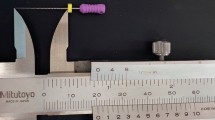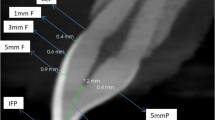Abstract
The objective of this study is to compare the estimated values of remaining dentin thickness (RDT) recorded by a newly introduced electrical impedance device (Prepometer) with cone beam computed tomography (CBCT) and histological in situ measurement. A total number of thirty human molars were used in this study. A deep class I cavity was prepared. The RDT for each cavity was measured with Prepometer in three different points (mesial, middle, and distal). Same specimens were imaged with high-resolution Cone Beam Computed Tomography CBCT (0.1 mm voxel size) using I CAT next Generation Machine (Imaging Science International, Hatfield, PA, USA), to provide the highest possible accuracy of linear measurements. Finally, the specimens were vertically sectioned parallel to the long axis of the tooth in a mesiodistal direction splitting the cavity into two halves through its center. Then, the actual RDT of each half will be measured in the same three points using a digital caliper. The outcome of one-way ANOVA revealed that there was no significant difference in RDT values measured by prepometer device, CBCT, or histological sectioning methods (p > 0.05). Within the limitations of this laboratory study, prepometer seems to be a potential non-invasive accurate measuring tool for RDT. Based on the findings of this study, the Prepometer can be considered as an easily handled and less-expensive method compared to CBCT to evaluate the RDT. Also, it can be used in dental schools and with less-experienced operators to avoid traumatic exposures of the dental pulp.



Similar content being viewed by others
References
Lancaster PE, Craddock HL, Carmichael FA. Estimation of remaining dentine thickness below deep lesions of caries. Br Dent J. 2011;211(10):E20.
Hatton JF, et al. In vitro and in vivo measurement of remaining dentin thickness. J Endod. 1994;20(12):580–4.
Davis GR, et al. Quantification of residual dentine thickness following crown preparation. J Dent. 2012;40(7):571–6.
Xu J, et al. Accuracy of cone-beam computed tomography in measuring dentin thickness and its potential of predicting the remaining dentin thickness after removing fractured instruments. J Endod. 2017;43(9):1522–7.
Krause F, et al. Laser fluorescence measurements compared to electrical resistance of residual dentine in excavated cavities in vivo. Caries Res. 2007;41(2):135–40.
Fujita R, et al. Measurement of the remaining dentin thickness using optical coherence tomography for crown preparation. Dent Mater J. 2014;33(3):355–62.
Zhu Y, et al. Origin and clinical applications of neural crest-derived dental stem cells. Chin J Dent Res. 2018;21(2):89–100.
Mjör IA, Odont D. Pulp-dentin biology in restorative dentistry. Part 2: initial reactions to preparation of teeth for restorative procedures. Quintessence Int. 2001;32(7):537–51.
Cohen S, Hargreaves KM. Pathways of the pulp. 9th ed. St. Louis: Mosby; 2006. p. 460–540.
Pashley DH. Dynamics of the pulpo-dentin complex. Crit Rev Oral Biol Med. 1996;7(2):104–33.
Vongsavan N, Matthews B. Changes in pulpal blood flow and in fluid flow through dentine produced by autonomic and sensory nerve stimulation in the cat. Proc Finn Dent Soc. 1992;88(Suppl 1):491–7.
Murray PE, et al. Human odontoblast cell numbers after dental injury. J Dent. 2000;28(4):277–85.
Murray PE, et al. Postoperative pulpal and repair responses. J Am Dent Assoc. 2000;131(3):321–9.
Murray PE, et al. Remaining dentine thickness and human pulp responses. Int Endod J. 2003;36(1):33–43.
Wierinck E, et al. Effect of augmented visual feedback from a virtual reality simulation system on manual dexterity training. Eur J Dent Educ. 2005;9(1):10–6.
Buyukgural B, Cehreli ZC. Effect of different adhesive protocols vs calcium hydroxide on primary tooth pulp with different remaining dentin thicknesses:24-month results. Clin Oral Investig. 2008;12(1):91–6.
Waltrick KB, et al. Accuracy of linear measurements and visibility of the mandibular canal of cone-beam computed tomography images with different voxel sizes: an in vitro study. J Periodontol. 2013;84(1):68–77.
Majkut PDDS, et al. Validation of optical coherence tomography against micro–computed tomography for evaluation of remaining coronal dentin thickness. J Endod. 2015;41(8):1349–52.
Fernandes TMF, et al. Comparison between 3D volumetric rendering and multiplanar slices on the reliability of linear measurements on CBCT images: an in vitro study. J Appl Oral Sci. 2015;23(1):56–63.
Shaheen E, et al. Accuracy of segmentation of tooth structures using 3 different CBCT machines. Oral Surg Oral Med Oral Pathol Oral Radiol. 2017;123(1):123–8.
Poleti ML, et al. Analysis of linear measurements on 3D surface models using CBCT data segmentation obtained by automatic standard pre-set thresholds in two segmentation software programs: an in vitro study. Clin Oral Invest. 2016;20(1):179–85.
Shaikh SY, Shaikh SS. Direct linear measurement of root dentin thickness and dentin volume changes with post space preparation: a cone-beam computed tomography study. Contemp Clin Dent. 2018;9(1):77–82.
Kamal RP, Faraj BM, Fahim R. Estimation of remaining dentine thickness (RDT) under caries lesion with a cone-beam computed tomography and standardized paralleling technique in comparisons to actual measurement. In vitro comparative study. Mod App Dent. Oral Health. 2021;1(5):431–6.
Fokas G, et al. Accuracy of linear measurements on CBCT images related to presurgical implant treatment planning: a systematic review. Clin Oral Implants Res. 2018;29(Suppl 16):393–415.
Ludlow JB, Walker C. Assessment of phantom dosimetry and image quality of i-CAT FLX cone-beam computed tomography. Am J Orthod Dentofacial Orthop. 2013;144(6):802–17.
Purton DG, et al. A novel instrument to determine pulp proximity. Eur J Prosthodont Restor Dent. 2009;17(1):30.
Violich DR, et al. Effect of the smear layer on a pulp proximity-indicating instrument. Odontology. 2012;100(1):47–53.
Gente M, Wenz HJ. Non-invasive method of measuring dentin resistance to the limit of the preparation depth. Dtsch Zahnarztl Z. 1991;46(11):771–3.
Tielemans S, et al. Evaluation of a preparation depth controlling device: a pilot study. Quintessence Int. 2007;38(2):135–42.
Schulte A, et al. The electrical resistance of enamel-dentine cylinders Influence of NaCl content in storage solutions. J Dent. 1998;26(2):113–8.
Hilgers ML, et al. Accuracy of linear temporomandibular joint measurements with cone beam computed tomography and digital cephalometric radiography. Am J Orthod Dentofacial Orthop. 2005;128(6):803–11.
Brown AA, et al. Linear accuracy of cone beam CT derived 3D images. Angle Orthod. 2009;79(1):150–7.
Bunn DL, et al. Accuracy of cone-beam computed tomography in measuring the thickness of radicular dentin. Braz Dent J. 2020;31(5):516–22.
Damstra J, et al. Accuracy of linear measurements from cone-beam computed tomography-derived surface models of different voxel sizes. Am J Orthod Dentofacial Orthop. 2010;137(1):16 e1-26 (discussion 16-7).
Mumford J. Path of direct current in electrical pulp testing using one coronal electrode. Br Dent J. 1959;106:23–6.
Funding
This work is self-funded and does not supported by any third-party funding.
Author information
Authors and Affiliations
Corresponding author
Ethics declarations
Conflict of interest
Hebatallah Sarhan declares that he has no conflict of interest. Hamdi Hamama declares that he has no conflict of interest. Wael Aboelmaaty declares that he has no conflict of interest. Ahmed Zaeneldin declares that he has no conflict of interest. Salah Mahnoud declares that he has no conflict of interest.
Ethical approval
The collection process of extracted teeth used in this study was approved by the Faculty of Dentistry Research Ethics Committee. Also, standard written consents were obtained from each patient agreeing to donate their extracted teeth for research purpose.
Additional information
Publisher's Note
Springer Nature remains neutral with regard to jurisdictional claims in published maps and institutional affiliations.
Rights and permissions
About this article
Cite this article
Sarhan, H., Hamama, H., Aboelmaaty, W. et al. Accuracy of an electrical impedance device in estimation of remaining dentin thickness vs cone beam computed tomography. Odontology 110, 489–496 (2022). https://doi.org/10.1007/s10266-021-00681-6
Received:
Accepted:
Published:
Issue Date:
DOI: https://doi.org/10.1007/s10266-021-00681-6




